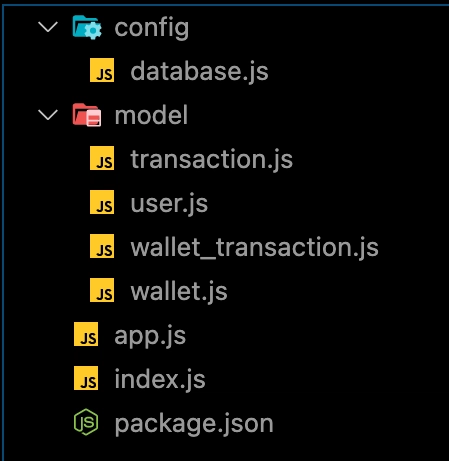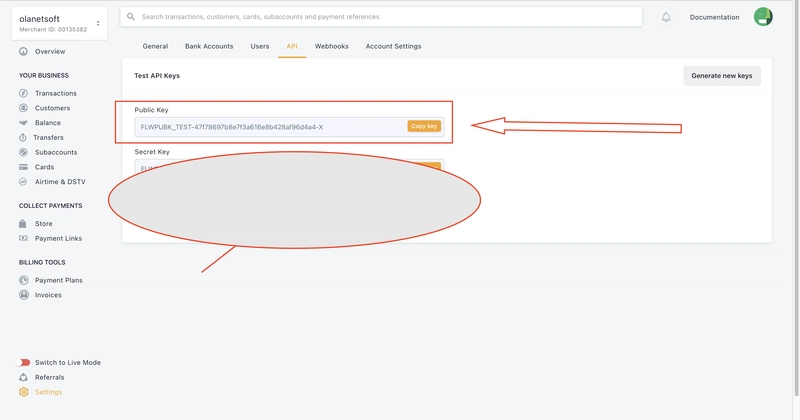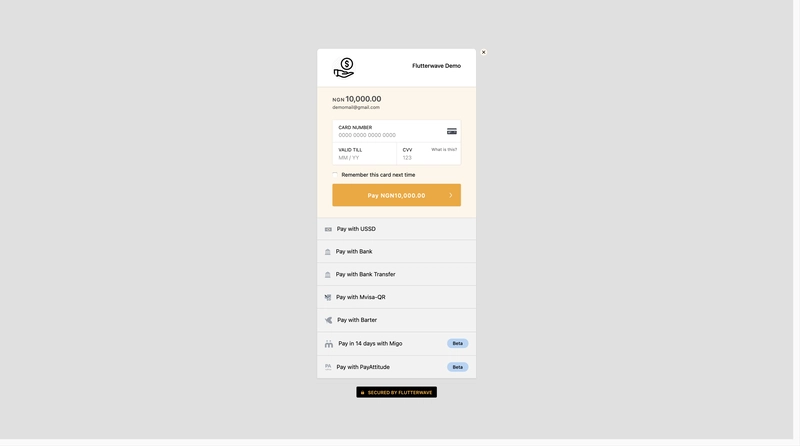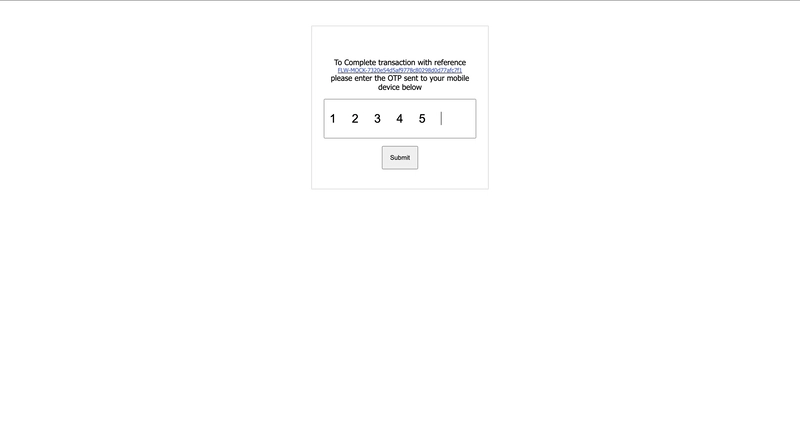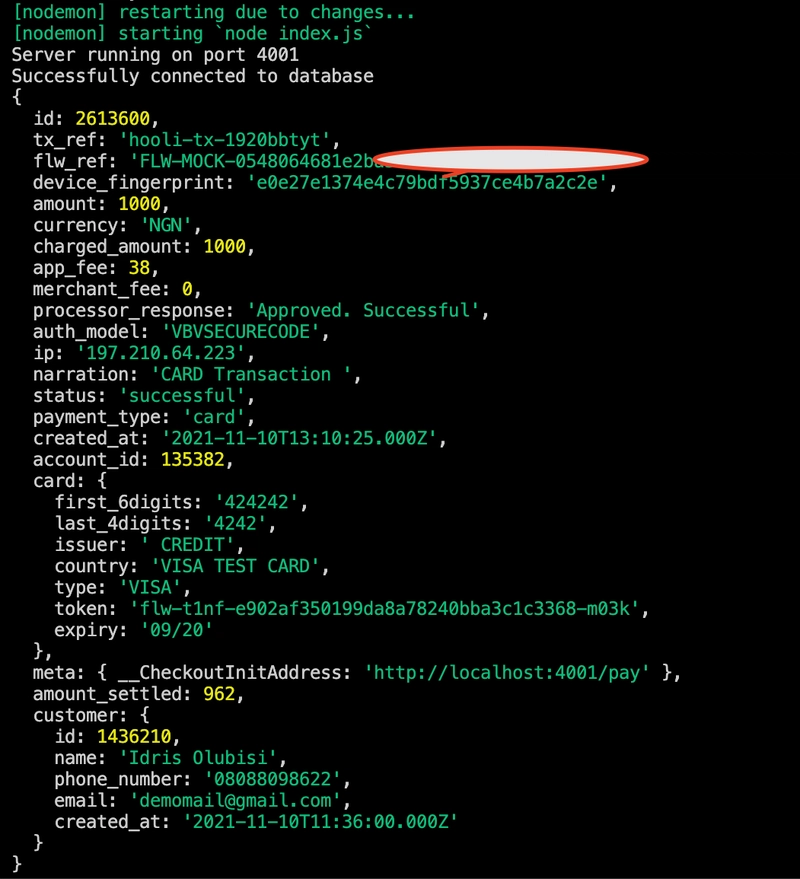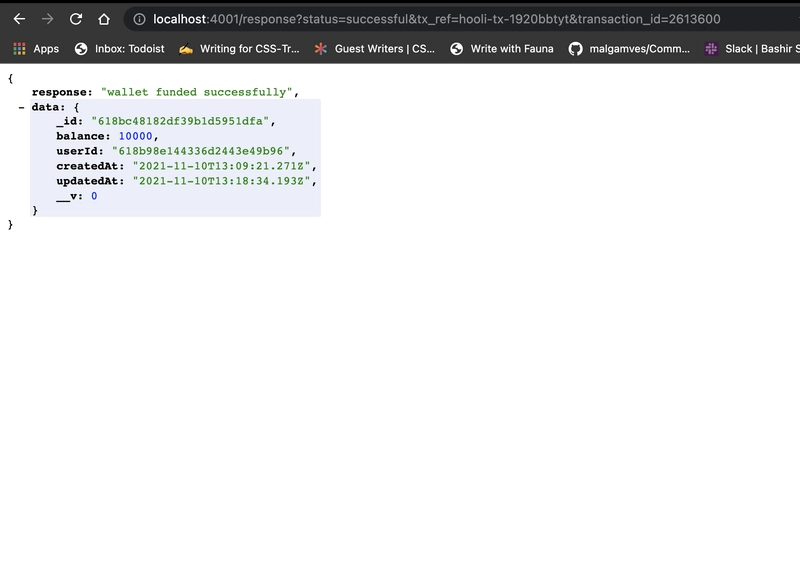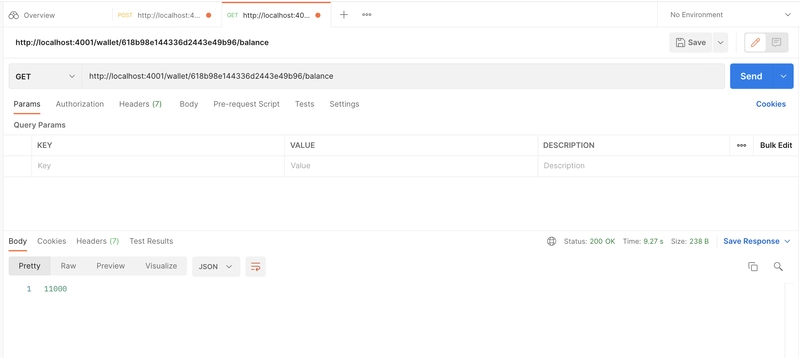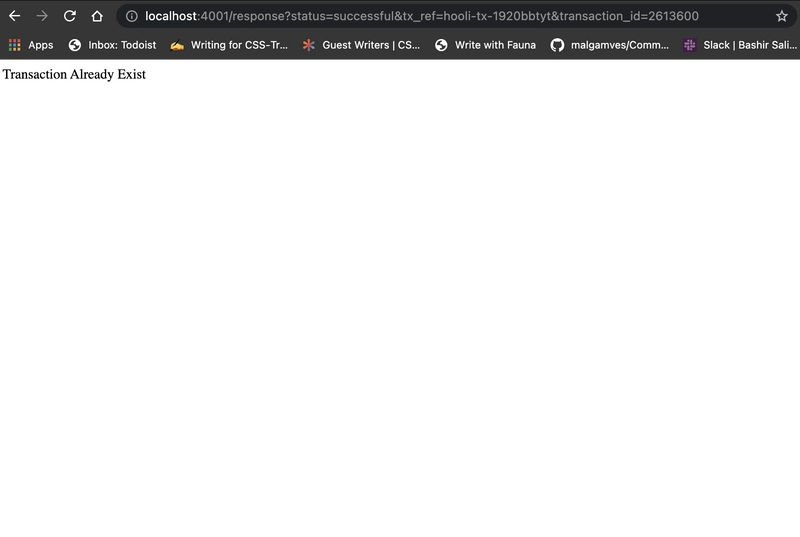如何将 Flutterwave 支付集成到 Node.js 应用程序中,构建钱包系统
如今,许多网站所有者都希望拥有在线支付网关,尤其是在该行业飞速发展的今天。在为医疗、金融或其他行业设计应用程序时,创建钱包系统简直是一场噩梦。
在本教程中,我们将学习如何创建钱包系统以及如何集成 Flutterwave 支付系统。
先决条件
为了学习本教程,我们需要:
- 具备 JavaScript 的工作知识。
- 对 Node.js 有很好的理解。
- 对 MongoDB 或我们选择的任何数据库有基本的了解。
- Postman以及一些有关如何使用 Postman 的知识。
我们还需要一个Flutterwave帐户来接收或接受来自我们应用程序的付款。
什么是钱包系统?
数字钱包,通常称为电子钱包,是一种电子设备、互联网服务或软件应用程序,允许一方用数字货币单位与另一方交换产品和服务。这包括使用电脑在线购物或使用智能手机在商店购物。
在进行任何交易之前,可以将钱存入数字钱包,或者在其他情况下可以将个人银行账户链接到数字钱包。
数字钱包有哪些好处?
-
每次进行网上交易时,您无需从鼓鼓囊囊的钱包里掏出卡片,只需拿着智能手机,登录您的账户,就可以开始交易了。
-
大多数应用程序允许您以易于访问的方式组织所有信息,从而节省您在钱包里翻找所需东西的时间。
-
许多数字钱包应用程序为用户提供各种奖金和奖品,这可能有助于您在特定交易中获得更多“收益”。
Flutterwave 是什么?
从在线收款到付款以及其间的一切,Flutterwave可以帮助您针对特定用例开发任何形式的支付流程。
他们还提供多种服务,让您在几分钟内即可在全球范围内转账和收款。
创建目录、安装依赖项并设置身份验证
首先,我们需要设置我们的项目。
通过导航到我们机器上选择的目录并在终端上打开它来打开 Visual Studio Code。
然后执行:
code.
注意:
code .如果我们的系统上没有安装 Visual Studio Code,它将无法工作。
创建目录并初始化npm.
通过输入以下命令创建目录并初始化 npm:
- Windows 电源外壳
mkdir wallet-demo-with-flutterwave
cd wallet-demo-with-flutterwave
npm init -y
- Linux
mkdir wallet-demo-with-flutterwave
cd wallet-demo-with-flutterwave
npm init -y
创建文件和目录
在前面的步骤中,我们npm使用命令进行了初始化npm init -y,该命令自动创建了一个package.json。
我们需要创建模型、配置目录和文件,例如,wallet.js, wallet_transaction.js, transaction.js, database.js使用以下命令。
mkdir model config
touch config/database.js model/wallet.js
model/wallet_transaction.js model/transaction.js
model/user.js
我们现在可以使用命令在项目的根目录中创建index.js和文件。app.js
touch app.js index.js
如下图所示:
安装依赖项
我们将安装几个依赖项,例如mongoose, jsonwebtoken, express, dotenv, axios, bcryptjs,开发依赖项,以便nodemon在我们自动进行更改时重新启动服务器。
我们将安装 mongoose,因为我将在本教程中使用 MongoDB。
我们将根据数据库中的信息检查用户凭证。因此,整个身份验证过程并不局限于本教程中使用的数据库。
npm install jsonwebtoken dotenv mongoose express bcryptjs axios
npm install nodemon -D
创建 Node.js 服务器并连接数据库
通过按顺序将以下代码片段添加到我们的 app.js、index.js、database.js、.env 中,我们现在可以创建我们的 Node.js 服务器并将其连接到我们的数据库。
在我们的database.js.
config/database.js:
const mongoose = require("mongoose");
const { MONGO_URI } = process.env;
exports.connect = () => {
// Connecting to the database
mongoose
.connect(MONGO_URI, {
useNewUrlParser: true,
useUnifiedTopology: true,
})
.then(() => {
console.log("Successfully connected to database");
})
.catch((error) => {
console.log("database connection failed. exiting now...");
console.error(error);
process.exit(1);
});
};
在我们的 app.js 中:
wallet-demo-with-flutterwave/app.js
require("dotenv").config();
require("./config/database").connect();
const express = require("express");
const bcrypt = require("bcryptjs");
const jwt = require("jsonwebtoken");
const app = express();
app.use(express.json());
// Logic here
module.exports = app;
在我们的index.js中:
wallet-demo-with-flutterwave/index.js
const http = require("http");
const app = require("./app");
const server = http.createServer(app);
const { API_PORT } = process.env;
const port = process.env.PORT || API_PORT;
// server listening
server.listen(port, () => {
console.log(`Server running on port ${port}`);
});
如果你注意到,我们的文件需要一些环境变量。我们将.env在启动应用程序之前创建一个新文件并添加变量。
在我们的 .env 中。
API_PORT=4001
MONGO_URI= //Your database URI here
要启动我们的服务器,请编辑 package.json 中的脚本对象,使其看起来像下面这样。
"scripts": {
"start": "node index.js",
"dev": "nodemon index.js",
"test": "echo \"Error: no test specified\" && exit 1"
}
上面的代码片段已成功插入app.js, index.js, and database.js.首先,我们构建了我们的 node.js 服务器index.js并导入了app.js配置了路由的文件。
然后,正如所示,database.js,我们使用 mongoose 创建与数据库的连接。
执行命令npm run dev。
服务器和数据库都应该正常运行并且不会崩溃。
创建用户模型和路线
我们将在用户首次注册时定义用户详细信息的模式,并在登录时根据保存的凭据对其进行验证。
将以下代码片段添加到模型文件夹内的 user.js 中。
model/user.js
const mongoose = require("mongoose");
const userSchema = new mongoose.Schema({
first_name: { type: String, default: null },
last_name: { type: String, default: null },
email: { type: String, unique: true },
password: { type: String },
});
module.exports = mongoose.model("user", userSchema);
现在让我们分别创建注册和登录的路由。
app.js根目录中的文件,我们将添加以下代码片段用于用户注册和登录。
// importing user context
const User = require("./model/user");
// Register
app.post("/register", (req, res) => {
// our register logic goes here...
});
// Login
app.post("/login", (req, res) => {
// our login logic goes here
});
实现注册和登录功能
我们将在应用程序中实现这两个路由。我们将使用 JWT 签名凭证,并使用 bycrypt 加密密码,然后再将其存储到数据库中。
从 /register 路线,我们将:
- 获取用户输入。
- 验证用户输入。
- 验证用户是否已经存在。
- 对用户密码进行加密。
- 在我们的数据库中创建一个用户。
- 最后,创建一个签名的 JWT 令牌。
修改我们之前创建的 /register 路由结构,使其如下所示。
// ...
app.post("/register", async (req, res) => {
// Our register logic starts here
try {
// Get user input
const { first_name, last_name, email, password } = req.body;
// Validate user input
if (!(email && password && first_name && last_name)) {
res.status(400).send("All input is required");
}
// check if user already exist
// Validate if user exist in our database
const oldUser = await User.findOne({ email });
if (oldUser) {
return res.status(409).send("User Already Exist. Please Login");
}
//Encrypt user password
encryptedPassword = await bcrypt.hash(password, 10);
// Create user in our database
const user = await User.create({
first_name,
last_name,
email: email.toLowerCase(), // sanitize: convert email to lowercase
password: encryptedPassword,
});
// Create token
const token = jwt.sign(
{ user_id: user._id, email },
process.env.TOKEN_KEY,
{
expiresIn: "2h",
}
);
// save user token
user.token = token;
// return new user
res.status(201).json(user);
} catch (err) {
console.log(err);
}
// Our register logic ends here
});
// ...
注意:使用 TOKEN_KEY 更新您的 .env 文件,它可以是一个随机字符串。
使用Postman测试端点,注册成功后我们将得到如下所示的响应。
/login
// ...
app.post("/login", async (req, res) => {
// Our login logic starts here
try {
// Get user input
const { email, password } = req.body;
// Validate user input
if (!(email && password)) {
res.status(400).send("All input is required");
}
// Validate if user exist in our database
const user = await User.findOne({ email });
if (user && (await bcrypt.compare(password, user.password))) {
// Create token
const token = jwt.sign(
{ user_id: user._id, email },
process.env.TOKEN_KEY,
{
expiresIn: "2h",
}
);
// save user token
user.token = token;
// user
res.status(200).json(user);
}
res.status(400).send("Invalid Credentials");
} catch (err) {
console.log(err);
}
// Our login logic ends here
});
// ...
单击此处了解有关如何在 Node.js 中使用 JWT 令牌构建身份验证 API 的更多信息
使用 Flutterwave 支付集成构建钱包系统
既然我们已经在上一步中成功创建了用户收集和身份验证功能,那么我们现在可以利用用户详细信息来构建钱包、保存钱包交易以及在系统中执行其他操作。
让我们使用以下代码更新我们的 wallet.js、wallet_transaction 和 transaction。
model/wallet.js
const { Schema, model } = require("mongoose");
const walletSchema = Schema(
{
balance: { type: Number, default: 0 },
userId: {
type: Schema.Types.ObjectId,
required: true,
ref: "users",
},
},
{ timestamps: true }
);
module.exports = model("wallet", walletSchema);
model/wallet_transaction.js
const mongoose = require("mongoose");
const walletTransactionSchema = new mongoose.Schema(
{
amount: { type: Number, default: 0 },
// Even though user can be implied from wallet, let us
// double save it for security
userId: {
type: String,
ref: "users",
required: true,
},
isInflow: { type: Boolean },
paymentMethod: { type: String, default: "flutterwave" },
currency: {
type: String,
required: [true, "currency is required"],
enum: ["NGN", "USD", "EUR", "GBP"],
},
status: {
type: String,
required: [true, "payment status is required"],
enum: ["successful", "pending", "failed"],
},
},
{ timestamp: true }
);
module.exports = mongoose.model("walletTransaction", walletTransactionSchema);
model/transaction.js
const mongoose = require("mongoose");
const transactionSchema =new mongoose.Schema(
{
userId: {
type: Schema.Types.ObjectId,
ref: "user",
},
transactionId: {
type: Number,
trim: true,
},
name: {
type: String,
required: [true, "name is required"],
trim: true,
},
email: {
type: String,
required: [true, "email is required"],
trim: true,
},
phone: {
type: String,
},
amount: {
type: Number,
required: [true, "amount is required"],
},
currency: {
type: String,
required: [true, "currency is required"],
enum: ["NGN", "USD", "EUR", "GBP"],
},
paymentStatus: {
type: String,
enum: ["successful", "pending", "failed"],
default: "pending",
},
paymentGateway: {
type: String,
required: [true, "payment gateway is required"],
enum: ["flutterwave"], // Payment gateway might differs as the application grows
},
},
{
timestamps: true,
}
);
module.exports = mongoose.model("Transaction", transactionSchema);
我们已经创建了钱包、钱包交易和交易模式,这意味着我们现在可以从客户端接收资金,在后端使用 flutterwave 验证付款,分别在钱包、钱包交易和交易集合中记录和更新付款详细信息。
让我们让前端客户端准备好接受来自客户的付款。
我们将使用以下命令index.html在我们的根目录中创建一个文件。
touch index.html
index.html使用下面的代码片段更新我们刚刚创建的内容:
<!DOCTYPE html>
<html lang="en">
<head>
<meta charset="UTF-8" />
<meta name="viewport" content="width=device-width, initial-scale=1.0" />
<title>Receive Payment</title>
</head>
<body>
<form>
<script src="https://checkout.flutterwave.com/v3.js"></script>
<button type="button" onClick="makePayment()">Pay Now</button>
</form>
<script>
function makePayment() {
FlutterwaveCheckout({
public_key: "YOUR_PUBLIC_KEY_HERE",
tx_ref: "hooli-tx-1920bbtyt",
amount: 1000,
currency: "NGN",
country: "NG",
payment_options: "card",
// specified redirect URL
redirect_url: "http://localhost:4001/response",
// use customer details if user is not logged in, else add user_id to the request
customer: {
email: "demomail@gmail.com",
phone_number: "08088098622",
name: "Idris Olubisi",
},
callback: function (data) {
console.log(data);
},
onclose: function () {
// close modal
},
customizations: {
title: "Flutterwave Demo",
description: "Flutterwave Payment Demo",
logo: "https://cdn.iconscout.com/icon/premium/png-256-thumb/payment-2193968-1855546.png",
},
});
}
</script>
</body>
</html>
您可以从Flutterwave 文档中了解有关上述代码片段的更多信息
更新我们的从服务器端app.js呈现文件,我们将使用以下代码片段:index.html
const path = require('path');
// ...
app.post("/login", async (req, res) => {
//...
}
// Add the route below
app.get("/pay", (req, res) => {
res.sendFile(path.join(__dirname + "/index.html"));
//__dirname : It will resolve to your project folder.
});
//...
在测试应用程序之前,我们会在之前创建的“index.html”中看到“YOUR_PUBLIC_KEY_HERE”这句话,这意味着我们需要一个来自Flutterwave 仪表板的公钥。让我们前往仪表板来检索我们的公钥。
让我们在浏览器中输入 来测试一下http://localhost:4001/pay。点击按钮后,我们应该看到类似下面的内容Pay Now:
我们将使用测试卡号:4242424242424242、有效期:04/25和 CVV:。由于我们使用的是测试卡202,因此我们将被重定向到下面的页面以输入 OTP 。12345
输入 OTP 后,我们会被重定向到 localhost:3000/response,但什么也不会发生。让我们通过实现处理接下来发生的逻辑来解决这个问题。
创建 ./response端点后,我们将使用以下代码片段更新我们的 app.js:
//...
app.get("/response", async (req, res) => {
const { transaction_id } = req.query;
// URL with transaction ID of which will be used to confirm transaction status
const url = `https://api.flutterwave.com/v3/transactions/${transaction_id}/verify`;
// Network call to confirm transaction status
const response = await axios({
url,
method: "get",
headers: {
"Content-Type": "application/json",
Accept: "application/json",
Authorization: `${process.env.FLUTTERWAVE_V3_SECRET_KEY}`,
},
});
console.log(response.data.data)
});
transaction_id我们从上面代码中回调的查询参数中获取,并通过向 Flutterwave 端点发送请求来验证交易。我们应该在日志中看到类似以下截图的内容。
让我们创建一个逻辑来管理诸如验证用户钱包、创建钱包交易和交易等操作。
在我们的中app.js,让我们导入钱包、钱包交易和交易模型。
//...
// importing user context
const User = require("./model/user");
const Wallet = require("./model/wallet");
const WalletTransaction = require("./model/wallet_transaction");
const Transaction = require("./model/transaction");
//...
使用管理操作的逻辑更新 app.js:
app.get("/response", async (req, res) => {
//....
});
// Validating User wallet
const validateUserWallet = async (userId) => {
try {
// check if user have a wallet, else create wallet
const userWallet = await Wallet.findOne({ userId });
// If user wallet doesn't exist, create a new one
if (!userWallet) {
// create wallet
const wallet = await Wallet.create({
userId,
});
return wallet;
}
return userWallet;
} catch (error) {
console.log(error);
}
};
// Create Wallet Transaction
const createWalletTransaction = async (userId, status, currency, amount) => {
try {
// create wallet transaction
const walletTransaction = await WalletTransaction.create({
amount,
userId,
isInflow: true,
currency,
status,
});
return walletTransaction;
} catch (error) {
console.log(error);
}
};
// Create Transaction
const createTransaction = async (
userId,
id,
status,
currency,
amount,
customer
) => {
try {
// create transaction
const transaction = await Transaction.create({
userId,
transactionId: id,
name: customer.name,
email: customer.email,
phone: customer.phone_number,
amount,
currency,
paymentStatus: status,
paymentGateway: "flutterwave",
});
return transaction;
} catch (error) {
console.log(error);
}
};
// Update wallet
const updateWallet = async (userId, amount) => {
try {
// update wallet
const wallet = await Wallet.findOneAndUpdate(
{ userId },
{ $inc: { balance: amount } },
{ new: true }
);
return wallet;
} catch (error) {
console.log(error);
}
};
我们现在可以/response使用我们创建的所有函数来更新端点,以管理不同的操作。
//...
app.get("/response", async (req, res) => {
const { transaction_id } = req.query;
// URL with transaction ID of which will be used to confirm transaction status
const url = `https://api.flutterwave.com/v3/transactions/${transaction_id}/verify`;
// Network call to confirm transaction status
const response = await axios({
url,
method: "get",
headers: {
"Content-Type": "application/json",
Accept: "application/json",
Authorization: `${process.env.FLUTTERWAVE_V3_SECRET_KEY}`,
},
});
const { status, currency, id, amount, customer } = response.data.data;
// check if customer exist in our database
const user = await User.findOne({ email: customer.email });
// check if user have a wallet, else create wallet
const wallet = await validateUserWallet(user._id);
// create wallet transaction
await createWalletTransaction(user._id, status, currency, amount);
// create transaction
await createTransaction(user._id, id, status, currency, amount, customer);
await updateWallet(user._id, amount);
return res.status(200).json({
response: "wallet funded successfully",
data: wallet,
});
});
//...
瞧🥳我们快完成了,让我们测试一下我们的应用程序。完成付款后,我们应该得到类似下面的内容:
由于经过多次尝试,在尝试为我们的钱包注资时,我们在上面的屏幕截图中拥有余额10,000;但是,如果仔细完成这些程序,这个数字可能会有所不同。
让我们使用下面的代码片段创建一个端点来检索用户余额:
//...
app.get("/wallet/:userId/balance", async (req, res) => {
try {
const { userId } = req.params;
const wallet = await Wallet.findOne({ userId });
// user
res.status(200).json(wallet.balance);
} catch (err) {
console.log(err);
}
});
//...
测试返回用户余额的端点:
注意:我们可能注意到,如果在重定向到“/response”端点后重新加载页面,相同金额的相同交易会更新到我们的钱包中。为了防止这种情况,我们必须验证
transaction_id系统中是否存在此类交易;否则,我们将收到重复交易错误。
我们可以修改我们的逻辑,如下所示:
//...
app.get("/response", async (req, res) => {
const { transaction_id } = req.query;
//...
const { status, currency, id, amount, customer } = response.data.data;
// check if transaction id already exist
const transactionExist = await Transaction.findOne({ transactionId: id });
if (transactionExist) {
return res.status(409).send("Transaction Already Exist");
}
//...
return res.status(200).json({
response: "wallet funded successfully",
data: wallet,
});
});
接下来,当我们刷新页面时,我们应该会看到类似于下面的屏幕截图的内容。
完整代码可在GitHub上获取
结论
在本文中,我们学习了如何在 Node.js 应用程序中构建一个简单的身份验证、钱包系统和 Flutterwave 支付集成
参考
我很乐意通过Twitter | LinkedIn | GitHub | Portfolio与您联系
下篇博文再见!保重!!!
文章来源:https://dev.to/olanetsoft/how-to-build-a-wallet-system-with-flutterwave- payment-integration-into-nodejs-application-175b 后端开发教程 - Java、Spring Boot 实战 - msg200.com
后端开发教程 - Java、Spring Boot 实战 - msg200.com
